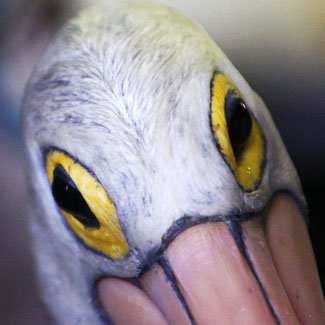Mysteries of the Australian pelican

WHILE STUDYING THE ECOLOGY of the Coongie Lakes in far north-east South Australia, I would sometimes lie back in awe and watch the spectacle of one or two thousand pelicans take off from one lake, flapping initially and increasingly soaring upward in spirals, until at a great height one bird would take the lead, break out of the thermal that was carrying it aloft and head for a distant lake, with successive birds peeling off one by one to follow its lead. It could take half an hour for a large flock to take flight in this staged manner, climb the thermals and follow the lines of departing birds to their new feeding grounds. This was a middle-of-the-day phenomenon, often late morning, when the thermals had begun to develop.
Being so large, on the rare occasions when pelicans congregate inland in huge flocks, they must consume staggering amounts of fish, and generally they cannot avoid making their presence known to humans in their midst.
THE AUSTRALIAN PELICAN (Pelecanus conspicillatus) has mythological significance for Aboriginal people. It was harvested for food by the Yandruwandha people in the Coongie Lakes, has long been persecuted and had nesting colonies destroyed by European fisher folk as perceived competitors for their fish stocks. It learns quickly to capitalise on human and other novel sources of food (friendly anglers, municipal garbage dumps), and is a common sight around wharves and harbours in coastal Australian towns, particularly fishing centres.
Amongst the heaviest flying birds in the world, pelicans as a group evolved from marine ancestors, but six of the seven species including the Australian pelican spend most of their time on rivers, lakes, inland seas and coastal waters. Male Australian pelicans can weigh in excess of 10 kg, but 8 kg is a more usual upper weight. Recognised instantly by their massive bill and pouch, pelicans mainly eat fish, and they nest colonially. They soar spectacularly on thermals, occasionally to great heights (3000 m or more), and they display precise orchestration of movement when feeding cooperatively or flying in V formation.
THE POPULATION OF PELICANS in Australia is thought to number 300,000–500,000. However, there is a sharp contrast in many respects between the sight of a few pelicans scattered along the shore of coastal towns and that of tens of thousands of birds massed at breeding colonies on inland Australian floodwaters. As well as the obvious visual contrast, the dispersed small groups of coastal birds are an everyday and ‘everywhere’ occurrence, whereas the massive inland breeding aggregations are infrequent and episodic, in both time and space.
Viewed from one perspective, that of the location of a massive inland colony — 30,000–50,000 pairs in the four recorded examples* — this is classic boom-bust. One cannot imagine a more arid, harsh and unproductive ecosystem than the salt crust surface of Lake Eyre South in most years, yet in the first six months of 1990 following its flooding from local rains a year earlier, 100,000 pelicans successfully fledged as many as 90,000 chicks.
The same species forms small breeding colonies of tens to hundreds, rarely a few thousand, on an annual basis on many small islands in coastal and sub-coastal Australia. This is not the hallmark of a boom-bust species. It displays characteristics of both boom-bust and ‘regular-annual’ reproductive strategies. Behavioural flexibility and adaptability to new environments and resources (reservoirs, other unnatural impoundments, artificial islands, human garbage, exotic fish as prey) would seem to be defining features of the Australian pelican, as much as its anatomical features and colonial breeding that are prescribed by its membership of the pelican family.
*The four inland Pelican colonies recorded were Lake Cawndilla (Menindee Lakes, NSW), Lake Eyre South (SA), Lake Goolangirie (Coongie Lakes, SA), and Lake Machattie (Georgina River, QLD).
Julian Reid is a PhD Scholar at the Australian National University, specialising in Biological Diversity in Arid Australia.
This excerpt was reproduced with permission from ‘Boom and Bust: Bird Stories for a Dry Country‘, by L. Robin, R. Heinsohn & L. Joseph, published by CSIRO PUBLISHING, 2009.





